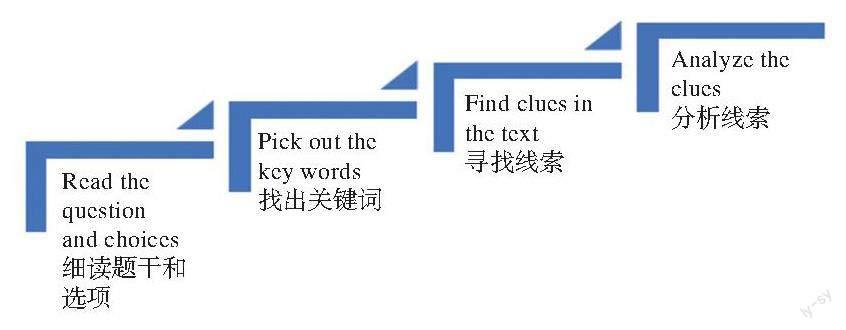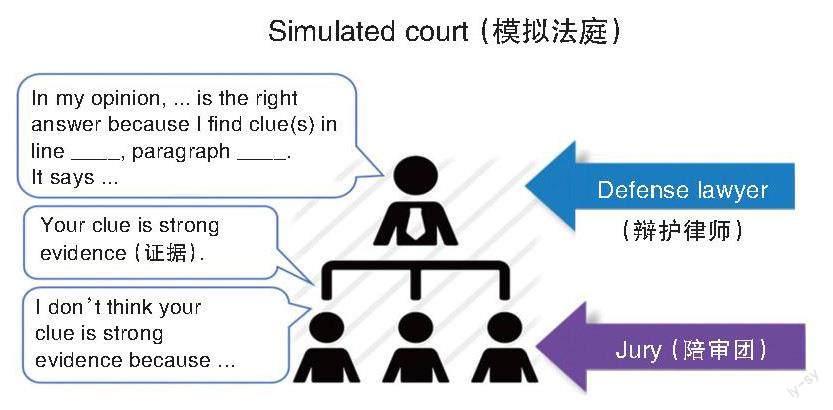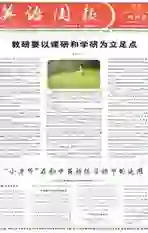巧用分析推理促进学生高阶思维发展
2024-01-20吴艳
吴艳



案例背景:在阅读过程中,准确地找到线索,进行“英英释义”(paraphrase),是初中生阅读得高分的关键。在以往的授课中,我发现学生事实细节题得分率很高,但对于需要寻找线索、进行分析推理的题目,得分率则比较低。在考试中,分析推理题经常出现在阅读理解的C篇和D篇中,阻碍了相当一部分学生拿高分。因此,在初一下学期的期末复习阶段,我设计了本课。
案例描述:今天的内容和以往的教学内容不同,我要带领学生解决让大多数人困扰的阅讀题中的“英英释义”的问题。学生做了课前测,我发现事实细节题90%的学生都能答对,但是细节分析、推理题正答率低于60%。这说明学生在做阅读题时不能准确地找到线索,进行分析、推理,从而不能完成“英英释义”。
环节一:引出问题
我先展示了昨天的细节分析、推理题,询问答错的学生是哪点困扰了他们。
题目:How did Jane learn so much about the chimpanzees?
A. She read a lot of books about chimpanzees.
B. She learned from her parents.
C. She made friends with them.
D. She got information on the Internet about chimpanzees.
正确答案为C。
答错的学生说,看到了有答案的段落(She watched them in the forest for many years. She knew every chimpanzee and even gave a name to each one. She lived with them in the wild. The chimpanzees thought she was one of them. In this way, Jane learned more about their lives.),但是没有分析和推理,找不到和选项一样的句子,就选错了。我说这类分析、推理题容易出错,原因是大家仍然停留在对文章的浅层理解上,没有进行高层次的思维活动。英文的英英意译有四个层次:1.能找出一个直接信息;2.能找出多个直接信息;3.能分析出细节之间的关联;4.能创造出抽象的新信息。前两个层次属于事实细节题,第三、四个层次属于细节分析、推理题。今天我们主要讲讲如何突破第三、四个层次。大家都非常期待接下来的课程。
环节二:构建思路
接下来,我分别举了三个例题。
例题1: I spent ten yuan buying this book.
A. I paid ten yuan for this book.
B. I spent ten hours reading this book.
C. I have ten yuan and would like to buy this
book.
学生们争先恐后地回答正确答案是A。我追问为什么,有的学生点明了:spent ... buying 等于paid ... for ...。
例题2: He was rich and famous all over the world.
A. He became famous all over the world because he was rich.
B. He had lots of money and was well?known in the world.
C. He was the richest man in the world so he became famous.
这道题有个别学生比较困惑,因为A、C选项都有rich 和famous。正确答案是B。关键点在于题干是rich and famous,而A的连接词是because,C的连接词是so,and 不等同于because 和so。
例题3:He hurried to school without breakfast.
A. He had breakfast at school.
B. He didnt go to school on time.
C. He didnt have breakfast and went to school in a hurry.
这道题有点绕弯,有的学生茫然了。我解释到hurried to ... without breakfast = went to ... in a hurry ... didnt have breakfast。
通过以上三道例题,我让学生总结“英英释义”应该注意什么。大家小组讨论,很快得出了结论:
这就是从浅层理解,通过高阶思维,进行分析、推理,从而得出正确的答案。
环节三:实践应用
为了巩固本节课的内容,我又呈现了两篇例文,从而做到句型层次向语篇层次的内化。
例文 1
Bob likes to keep his bedroom neat (整洁). He puts everything exactly where it belongs. When his cousin came for a visit, Bob became upset (心烦). Socks were on the floor, and nothing was where it was supposed to be. Bob was happy when his cousins visit was over.
Question: What can we know from the paragraph?
A. Bobs cousin puts everything in order.
B. Bobs cousin is not a neat person.
C. Bob was sad when his cousin left.
学生马上开始寻找线索。我提示大家,首先要细读题干和选项,找关键词。学生很快找到了关键词。
A. 关键词:put ... in order
B. 关键词:not neat
C. 关键词:sad
接着大家回到原文找线索,并分析、推理线索。
Bob likes to keep his bedroom neat (整洁). He puts everything exactly where it belongs. When his cousin came for a visit, Bob became upset (心烦). Socks were on the floor, and nothing was where it was supposed to be.从原文找到这句话后,通过分析,可以推断出Bobs cousin 来了之后,家里非常乱,得出Bobs cousin不是一个爱干净的人。显然A选项错误。Bob was happy when his cousins visit was over.与C选项不符合。通过以上分析和推理,得出正确答案为B。
做完第一篇,学生很快总结出做这类分析、推理高阶思维题的解题思路,即:
接下来,我出示了第二篇文章,学生们带着清晰的解题思路开始了答题。
例文 2
“Listen to this joke I made up,” said Betty. Then Betty told her friends a joke. None of her friends laughed. Finally, her friend Lily said, “Betty, that joke is just like all your jokes. Maybe you should stop trying to make us laugh.”
Question: Which of the following is TRUE?
A. Lilys friends listened to her joke.
B. Bettys jokes are not funny.
C. Bettys friends laughed at her joke.
因為有了解题思路,学生开始清晰地阐述自己的解题过程。
第一、二步 :细读题干和选项,找出关键词
A. listened to
B. not funny
C. laughed at
第三、四步:回到原文寻找线索,并进行分析、推理
“Listen to this joke I made up,” said Betty. Then Betty told her friends a joke. None of her friends laughed. Finally, her friend Lily said, “Betty, that joke is just like all your jokes. Maybe you should stop trying to make us laugh.”(线索是None, stop。分析和推理线索得出,大家觉得Betty的笑话不可笑)。通过以上四步,学生得出正确答案B。
环节四:拓展提升
为了在真实的语境中再次巩固今天所学的分析、推理高阶思维能力,我设置了学生非常感兴趣的模拟法庭辩论赛。
Passage
1 Where is the quietest place in the world? Is it in a forest, or on top of a mountain? Actually, the quietest place in the world is in a room at Microsoft headquarters (总部) in Washington, US.
2 The sound of a person breathing is about 10 decibels (分贝). The Microsoft room, however, measures (测量) -20.3 decibels, according to theDaily Mail.There is special foam (泡沫材料) all over the rooms walls and floor. Outside sounds cannot be heard inside the room.
3 Microsoft uses the room to test their products (产品). For example, they use it to make better speakers and headphones. They also use it to see how loud their mice (鼠标) are.
4 However, you might feel uncomfortable in this room. You can hear your own heartbeat and breathing inside the room. No one can stay inside for more than 45 minutes.
5 Fun facts about the room
● The rooms walls have six layers (层). Each wall is about 30 cm thick (厚).
● The room is very high. Its on the 87th floor of a building. This helps to keep out outside sounds.
● There are 68 springs (弹簧) underneath the room. This way, the room doesnt touch the ground (地面). Sounds from the ground cannot be heard inside the room.
1. What does Microsoft use this room to do?
A. To study quiet sound.
B. To improve their products.
C. To see how mice get around in the dark.
D. To discuss secrets.
2. Which of the following is TRUE about this rooms problem?
A. Peoples hearts will stop beating if they are in the room.
B. Some people cant breathe well inside this room.
C. People may not feel well if they stay in this room for long.
D. Only robots can work inside the room.
經过7分钟的思考,学生进行了展示。
学生1展示:Question 1
Defence lawyer: In my opinion, Question 1, the correct answer is B because I find clue in line 2&3, paragraph 3. It says “they use it to make better speakers and headphones. They also use it to see how loud their mice (鼠标) are”. 通过分析、推理,选项B正确。
Jury: Your clue is strong evidence.
学生2展示:Question 2
Defence lawyer: In my opinion, Question 2, the correct answer is C because I find clue in line 1, 2&3, paragraph 4.It says “However, you might feel uncomfortable in this room ... No one can stay inside for more than 45 minutes.”通过分析、推理,选项C 正确。
Jury:Your clue is strong evidence.
学生们在模拟法庭的真实情境中再次巩固了根据线索进行分析、推理,得出正确答案的思维方式。
案例分析:本节课在课标中的要求是“识别和判断书面语篇句子之间的逻辑关系;理解和推断说话者的意图。”依据布鲁姆教育目标分类法可知,这部分知识属于第二、四、六个目标,即:得到信息后,能用自己的话表达其中的意义;将信息分解,确定各部分之间、各部分与总体间的关系;能基于得到的信息,重新组织成新的模型或结构。达成这三个目标对于学生来说比较困难。因此,本节课从句子到语篇,一步步带着学生分析、推理,完成“英英释义”,进而总结出这类题的做题思路,让学生在实际练习中逐步形成高阶思维能力。通过模拟法庭的检测结果可以发现,学生在真实语境下,用英语表达自己经过分析、推理而得出结论的能力,通过教师的教学设计是可以慢慢培养的,为学生以后英语思辨能力的培养打下了良好的基础。
